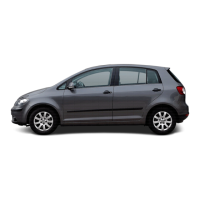P
r
o
t
e
c
t
e
d
b
y
c
o
p
y
r
i
g
h
t
.
C
o
p
y
i
n
g
f
o
r
p
r
i
v
a
t
e
o
r
c
o
m
m
e
r
c
i
a
l
p
u
r
p
o
s
e
s
,
i
n
p
a
r
t
o
r
i
n
w
h
o
l
e
,
i
s
n
o
t
p
e
r
m
i
t
t
e
d
u
n
l
e
s
s
a
u
t
h
o
r
i
s
e
d
b
y
V
o
l
k
s
w
a
g
e
n
A
G
.
V
o
l
k
s
w
a
g
e
n
A
G
d
o
e
s
n
o
t
g
u
a
r
a
n
t
e
e
o
r
a
c
c
e
p
t
a
n
y
l
i
a
b
i
l
i
t
y
w
i
t
h
r
e
s
p
e
c
t
t
o
t
h
e
c
o
r
r
e
c
t
n
e
s
s
o
f
i
n
f
o
r
m
a
t
i
o
n
i
n
t
h
i
s
d
o
c
u
m
e
n
t
.
C
o
p
y
r
i
g
h
t
b
y
V
o
l
k
s
w
a
g
e
n
A
G
.
4.2 General safety regulations when work‐
ing on airbag, belt tensioner and battery
isolator units (pyrotechnic components)
WARNING
♦ Pyrotechnic components always contain a propellant that
generates a gas during combustion. On some versions, a
separate compressed gas reservoir is available to gener‐
ate the gas.
♦ This compressed gas is stored under high pressure in a
compressed gas tank.
♦ Ignition of the pyrotechnic components is by means of an
electric/mechanical igniter.
♦ Testing, removing, installing and repair work may only be
performed by qualified personnel.
♦ For airbag units, there are no exchange intervals.
♦ Under no circumstances should checks be carried out with
a test lamp, voltmeter or ohmmeter.
♦ Pyrotechnic components may only be checked in installed
state and with vehicle diagnosis, testing and information
systems approved by the manufacturer.
♦ When working on pyrotechnic components and airbag
control unit -J234-, the battery earth strap must be dis‐
connected with the ignition switched on. Then cover neg‐
ative terminal.
♦ A waiting time of 10 seconds is necessary after discon‐
necting the battery.
♦ The battery must be connected with the ignition SWITCH‐
ED ON. When doing this, there should be no-one inside
the vehicle. Exception: Vehicles with battery inside pas‐
senger compartment. In this case do not stay anywhere
near the effective range of the airbags and seat belts.
♦ Wash hands after coming into contact with triggered py‐
rotechnic components of restraint system.
♦ Pyrotechnic components must not be opened or repaired;
always use new parts (risk of injury).
♦ Pyrotechnic components that have been dropped onto a
hard surface or show signs of damage must not be instal‐
led in a vehicle.
♦ Before handling pyrotechnic components of the restraint
system, for example before separating an electrical con‐
nection, the mechanic must electrostatically discharge
himself/herself. Electrostatic discharge is achieved by
touching earthed metallic parts, such as the door striker
plate.
♦ Pyrotechnic components must be installed immediately
after they have been removed from their packaging.
♦ If work is interrupted, the pyrotechnic component must be
stored back in its packaging.
♦ Leaving the pyrotechnic component unattended is pro‐
hibited.
♦ Pyrotechnic components must not come into contact with
grease, cleaning solution or similar.
♦ Pyrotechnic components must not be subjected to tem‐
peratures above 100 °C even for short periods.
Golf 2004 ➤ , Golf 2009 ➤
General body repairs, interior - Edition 05.2010
4. Airbag 115

